Are you curious to know what is normandy fencing? You have come to the right place as I am going to tell you everything about normandy fencing in a very simple explanation. Without further discussion let’s begin to know what is normandy fencing?
What Is Normandy Fencing?
Fencing is a captivating sport that combines grace, agility, and strategic thinking. While many people are familiar with traditional forms of fencing, such as foil, epee, and sabre, there are other lesser-known fencing styles that carry their own unique charm. In this blog post, we will explore the world of Normandy fencing, an elegant and historically rich form of swordplay originating from the picturesque region of Normandy, France.
Origins And History:
Normandy fencing, also known as “escrime normande” in French, traces its roots back to the medieval era. The region of Normandy, nestled in the northwestern part of France, has a long history of military culture and a deep connection to swordsmanship. The martial traditions of Normandy have been passed down through generations, evolving and adapting over time.
Techniques And Characteristics:
Normandy fencing incorporates a blend of both cutting and thrusting techniques, making it a versatile and well-rounded style of swordplay. The primary weapon used in Normandy fencing is the “épée de bocage,” a type of dueling sword with a straight, double-edged blade. Unlike other forms of fencing, Normandy fencing does not utilize specialized weapons such as foils or rapiers.
One of the distinguishing features of Normandy fencing is its emphasis on footwork and precise blade work. Practitioners strive for fluidity and grace in their movements, combining agility, speed, and control to execute accurate strikes and parries. The techniques often involve circular motions, deflecting and redirecting the opponent’s attacks while maintaining a balanced stance.
Training And Practice:
Normandy fencing is traditionally taught in a structured manner, with an emphasis on mastering the fundamental techniques and principles. Training begins with footwork drills, focusing on developing balance, agility, and coordination. As students progress, they learn different offensive and defensive techniques, including thrusts, cuts, and parries, which are practiced both individually and in partner drills.
Historical Context:
While Normandy fencing is primarily practiced as a sport today, it is essential to recognize its historical significance. In medieval times, swordsmanship was not only a skill for personal defense but also a reflection of one’s social status and honor. The techniques and strategies of Normandy fencing have their roots in the dueling culture and martial traditions prevalent during that era.
Preservation And Modern Practices:
In recent years, there has been a renewed interest in preserving and promoting the art of Normandy fencing. Dedicated instructors and enthusiasts have worked tirelessly to document the historical techniques and share them with a wider audience. Fencing clubs and schools in Normandy and other parts of the world now offer training in this unique style, allowing both locals and visitors to immerse themselves in the region’s rich cultural heritage.
Conclusion:
Normandy fencing stands as a testament to the historical legacy and artistic expression of swordplay in the Normandy region of France. With its blend of elegance, precision, and strategic thinking, this lesser-known style of fencing offers a fascinating journey into the world of martial arts. Whether one is an avid fencer or simply curious about the diverse forms of swordplay, exploring the techniques and traditions of Normandy fencing can be a rewarding and enriching experience.
Get Information About Advantages On Mainadvantages
FAQ
What Is A Normandy Fence?
Normandy Fencing
Named for the X-shaped barricades on Normandy beaches during D-Day, this fence type is designed to impede only vehicles.
Who Invented The Fence?
The Greeks were the first to use a fence. Although in Athens the land was kept based on social recognition, with no partitions, when they were outside of local boundaries, conquering territory in Asia Minor, the terrain was divided among themselves with partitions. Romans repeated the pattern.
Where Did The Term Fencing Come From?
Fencing derives from the Latin word “defensa”, which means “protection”. When the word moved into Old French, it transformed into “defens”, again meaning to protect. During the 15th century, the English shortened it to “fens” (because English does so many things to so many words!).
When Was The Fence Invented?
There are believed to be fence-like structures as part of the earliest known sedentary human civilizations, including in Mesopotamia, where the earliest civilizations began to form around 12000 B.C.E. That’s over 14,000 years ago!
I Have Covered All The Following Queries And Topics In The Above Article
What Is “Normandy Fencing”? D-Day
What Is Normandy Fencing?
What Is “Normandy Fencing”
What Is “Normandy Fencing”?
Normandy Fencing What Is
What Is A Normandy Fencing
What Is Normandy Fencing
What is the purpose of fencing
What is a ‘Normandy’ border fence?
